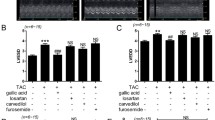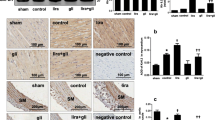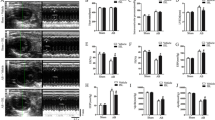Abstract
Objective
We investigated the effect of (−)-epigallocatechin-3-gallate (EGCG) on cardiac function and its mechanism, which focused on the desensitization of β1-AR and GRK2 in heart failure (HF) rats.
Methods
HF was induced by abdominal aortic coarctation. Four weeks after HF induction, the rats were given EGCG (25, 50, 100 mg/kg/day). Cardiac function was assessed by measuring haemodynamic parameters. Histological changes were analyzed by HE and Masson’s trichrome staining. The expression of β1-AR was detected by immunohistochemistry and immunofluorescence. The membrane expression of β1-AR and GRK2 was detected by western blot. The expression levels of β1-AR mRNA and GRK2 mRNA were evaluated by Q-PCR.
Result
Compared to the control group, the left ventricular end diastolic pressure, mean blood pressure, heart weight/body weight, and posterior wall thickness in the HF group were significantly increased, whereas the left ventricular systolic pressure, maximum rate of left ventricular pressure rise (+ dP/dt max) and maximum rate of left ventricular pressure fall (− dP/dt max) were clearly decreased. EGCG could improve cardiac function by regulating these parameters. Inflammatory cell infiltration, irregularly arranged cardiomyocytes, swelling of cardiomyocytes and myocardial fibrosis were observed in HF rats’ myocardial morphology, and EGCG obviously improved the morphological signs. The expression of β1-AR was significantly decreased in the left ventricle tissue of HF rats by immunohistochemistry and immunofluorescence. The membrane expression of β1-AR decreased, whereas GRK2 increased in vivo and in vitro by western blot. EGCG could down-regulate the membrane expression of GRK2 and up-regulate the expression of β1-AR. There were no significant differences in the total expression of β1-AR mRNA and GRK2 mRNA.
Conclusions
EGCG has therapeutic effects on the heart function of HF rats. The mechanism might be related to the inhibition of the transfer membrane of GRK2 and to the reduction of the desensitization of β1-AR.








Similar content being viewed by others
References
Arshad HR, Fahad MA, Khaled SA, Salah MA, Masood AK (2015) Implications of green tea and its constituents in the prevention of cancer via the modulation of cell signaling pathway. Biomed Res Int 2015:925640
Babu PV, Liu D (2008) Green tea catechins and cardiovascular health: an update. Curr Med Chem 15:1840–1850
Babu PV, Sabitha KE, Shyamaladevi CS (2008) Effect of green tea extract on advanced glycation and cross-linking of tail tendon collagen in streptozotocin induced diabetic rats. Food Chem Toxicol 46:280–285
Bojic T, Sudar E, Mikhailidis D, Alavantic D, Isenovic E (2012) The role of G protein coupled receptor kinases in neurocardiovascular pathophysiology. Arch Med Sci 8:970–977
Braunwald E (2015) The war against heart failure: the Lancet lecture. Lancet 385:812–824
Bristow MR (2011) Treatment of chronic heart failure with β-adrenergic receptor antagonists. Circ Res 109:1176–1194
Brodde OE, Leineweber K (2004) Autonomic receptor systems in the failing and aging human heart: similarities and differences. Eur J Pharmacol 500:167–176
Cai Y, Zhao L, Qin Y, Wu XQ (2015) egcg blocked phenylephrin-induced hypertrophy in H9C2 cardiomyocytes, by activating AMPK-dependent pathway. Korean J Physiol Pharmacol 19:203–210
Chen ZM, Lin Z (2015) Tea and human health: biomedical functions of tea active components and current issues. Zhejiang Univ Sci B 16:87–102
David H, Lin Y, Kousaku I, Dorothy EV, Stephen FV (2010) Modulation of β-adrenergic receptor signaling in heart failure and longevity: targeting adenylyl cyclase type 5. Heart Fail Rev 15:495–512
Dong A, Mueller P, Yang F, Yang L, Morris A, Smyth SS (2017) Direct thrombin inhibition with dabigatran attenuates pressure overload-induced cardiac fibrosis and dysfunction in mice. Thromb Res 159:58–64
Florea SM, Blatter LA (2012) Regulation of cardiac alternant by β-adrenergic signaling pathways. Am J Physiol Heart Circ Physiol 303:H1047–H1056
Gül B, David G, Harold L (2016) Heart failure: a major cardiovascular complication of diabetes mellitus. Curr Diab Rep 16:116
Hsieh SR, Hsu CS, Lu CH, Chen WC, Chiu CH, Liou YM (2013) Epigallocatechin-3-gallate-mediated cardioprotection by Akt/GSK-3β/caveolin signaling in H9c2 rat cardiomyoblasts. J Biomed Sci 20:86
Huang ZM, Gold JI, Koch WJ (2011) G protein-coupled receptor kinases in normal and failing myocardium. Front Biosci (Landmark Ed) 16:3047–3060
Huang ZM, Gao E, Chuprun JK, Walter JK (2014) GRK2 in the heart: a GPCR kinase and beyond. Antioxid Redox Signal 21:2032–2043
Jean-Charles PY, Yu SM, Abraham D, Kommaddi RP, Mao L, Strachan RT, Zhang ZS, Bowles DE, Brian L, Stiber JA, Jones SN, Koch WJ, Rockman HA, Shenoy SK (2017) Mdm2 regulates cardiac contractility by inhibiting GRK2-mediated desensitization of β-adrenergic receptor signaling. JCI Insight. https://doi.org/10.1172/jci.insight.95998
Khan N, Mukhtar H (2013) Tea and health: studies in humans. Curr Pharm Des 19:6141–6147
Kim HS, Montana V, Jang HJ, Parpura V, Kim J (2013) Epigallocatechin gallate (EGCG) stimulates autophagy in vascular endothelial cells: a potential role for reducing lipid accumulation. J Biol Chem 288:22693–22705
Liu Q, Molkentin JD (2011) Protein kinase Cα as a heart failure therapeutic target. J Mol Cell Cardiol 51:474–478
Matkovich SJ, Diwan A, Klanke JL, Hammer DJ, Marreez Y, Odley AM, Brunskill EW, Koch WJ, Schwartz RJ, Dorn GW (2006) Cardiac-specific ablation of G-protein receptor kinase 2 redefines its roles in heart development and beta-adrenergic signaling. Circ Res 99:996–1003
McMurray JJ, Adamopoulos S, Anker SD, Auricchio A, Böhm M, Dickstein K, Falk V, Filippatos G, Fonseca C (2012) ESC guidelines for the diagnosis and treatment of acute and chronic heart failure 2012: the Task Force for the Diagnosis and Treatment of Acute and Chronic Heart Failure 2012 of the European Society of Cardiology. Developed in collaboration with the Heart Failure Association (HFA) of the ESC. Eur J Heart Fail 14:803–869
Nolwenn M, Nicolas P, Bertrand R, Amandine G, Benjamin L, Jean-Noël T, Chantal G (2013) Increased Beta2-adrenoceptors in doxorubicin-induced cardiomyopathy in rat. PLoS One 8:e6471119
Ohte N, Narita H, Iida A, Fukuta H, Iizuka N, Hayano J, Kuge Y, Tamaki N, Kimura G (2012) Cardiac β-adrenergic receptor density and myocardial systolic function in the remote noninfarcted region after prior myocardial infarction with left ventricular remodeling. Eur J Nucl Med Mol Imaging 39:1246–1253
Potenza MA, Montagnani M, Nacci C, De Salvia MA (2016) Chronic treatment with epigallocatechin gallate reduces motor hyperactivity and affects in vitro tested intestinal motility of spontaneously hypertensive rats. Chronic Food Nutr Res 60:28373
Raake PW, Vinge LE, Gao E, Boucher M, Rengo G, Chen X, DeGeorge BJ, Matkovich S, Houser SR, Most P, Eckhart AD, Dorn GW, Koch WJ (2008) G protein-coupled receptor kinase 2 ablation in cardiac myocytes before or after myocardial infarction prevents heart failure. Circ Res 103:413–422
Sato PY, Chuprun JK, Schwartz M, Koch WJ (2015) The evolving impact of g protein-coupled receptor kinases in cardiac health and disease. Physiol Rev 95:377–404
Steinmann J, Buer J, Pietschmann T, Steinmann E (2013) Anti-infective properties of epigallocatechin-3-gallate (EGCG), a component of green tea. Br J Pharmacol 168:1059–1073
Wang Y, Ho CT (2009) Polyphenolic chemistry of tea and coffee: a century of progress. J Agric Food Chem 57:8109–8114
Wolfram S (2007) Effects of green tea and EGCG on cardiovascular and metabolic health. J Am Coll Nutr 26:373S–388S
Yoo B, Lemaire A, Mangmool S, Wolf MJ, Curcio A, Mao L, Rockman HA (2009) Beta1-adrenergic receptors stimulate cardiac contractility and CaMKII activation in vivo and enhance cardiac dysfunction following myocardial infarction. Am J Physiol Heart Circ Physiol 297:H1377–H1386
Zhang Q, Hu LQ, Yin CS, Chen P, Li HQ, Sun X, Yan G (2014) Catechin ameliorates cardiac dysfunction in rats with chronic heart failure by regulating the balance between Th17 and Treg cells. Inflamm Res 63:619–628
Acknowledgements
This work was financially supported by the Nature Science Foundation of Anhui (no. 1508085QH165).
Author information
Authors and Affiliations
Corresponding author
Ethics declarations
Conflict of interest
The authors report no conflicts of interest. The authors alone are responsible for the content and writing of the article.
Rights and permissions
About this article
Cite this article
Zhang, Q., Hu, L., Chen, L. et al. (−)-Epigallocatechin-3-gallate, the major green tea catechin, regulates the desensitization of β1 adrenoceptor via GRK2 in experimental heart failure. Inflammopharmacol 26, 1081–1091 (2018). https://doi.org/10.1007/s10787-017-0429-x
Received:
Accepted:
Published:
Issue Date:
DOI: https://doi.org/10.1007/s10787-017-0429-x




